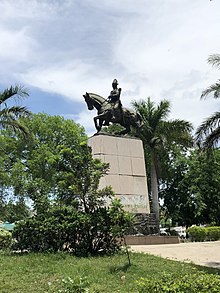
Back هنري كريستوف Arabic هنرى كريستوف ARZ هنری کریستوف AZB অঁরি ক্রিস্তফ Bengali/Bangla Enric I d'Haití Catalan Henri Christophe Czech Henri Christophe German Henriko la 1-a (Haitio) Esperanto Henri Christophe Spanish هنری کریستف Persian
| Henry I | |||||
|---|---|---|---|---|---|
| Defender of the Faith | |||||
 Portrait by Richard Evans c. 1816 | |||||
| King of Haiti | |||||
| Reign | 28 March 1811 – 8 October 1820 | ||||
| Coronation | 2 June 1811 | ||||
| Predecessor | Himself (as President of the State of Haiti) | ||||
| Successor | Henry II (unproclaimed) | ||||
| President of the State of Haiti | |||||
| In office | 17 February 1807 – 28 March 1811 | ||||
| Predecessor | Jacques I (as Emperor of Haïti) | ||||
| Successor | Himself (as King of Haiti) | ||||
| Born | 6 October 1767 British Grenada | ||||
| Died | 8 October 1820 (aged 53) Cap-Henri, Kingdom of Haiti | ||||
| Burial | Citadelle Laferriere, Haiti | ||||
| Consort | Marie-Louise Coidavid | ||||
| Issue | François-Ferdinand Christophe Princess Françoise-Améthyste Princess Anne-Athénaïre Jacques-Victor Henry, Prince Royal Baron Thomas de Belliard (illegitimate son) | ||||
| |||||
| Father | Christophe | ||||
| Religion | Roman Catholicism | ||||
| Coat of arms |  | ||||

Henri Christophe[1] (French pronunciation: [ɑ̃ʁi kʁistɔf]; 6 October 1767 – 8 October 1820) was a key leader in the Haitian Revolution and the only monarch of the Kingdom of Haiti.
Born in the British Caribbean, Christophe was possibly of Senegambian descent[2]. Beginning with the slave uprising of 1791, he rose to power in the ranks of the Haitian revolutionary military. The revolution succeeded in gaining independence from France in 1804. In 1805 he took part under Jean-Jacques Dessalines in the capture of Santo Domingo (now Dominican Republic), against French forces who acquired the colony from Spain in the Treaty of Basel.
After Dessalines was assassinated, Christophe retreated to the Plaine-du-Nord and created a separate government. On 17 February 1807, he was elected president of the State of Haiti, as he named that area. Alexandre Pétion was elected president of the Republic of Haiti in the south. On 26 March 1811, Christophe created a kingdom in the north and was later proclaimed Henry I, King of Haïti. He also created a nobility and named his legitimate son Jacques-Victor Henry as prince and heir.
He is known for constructing Citadel Henry, now known as Citadelle Laferrière, the Sans-Souci Palace, the royal chapel of Milot, the Palais de la Belle Rivière and numerous other palaces.[3] Under his policies of corvée, or forced labor bordering on slavery,[4] the Kingdom earned revenues from agricultural production, primarily sugar, but the Haitian people resented the system. He reached an agreement with the United Kingdom to respect its Caribbean colonies in exchange for their warnings to his government of any French naval activity threatening Haiti. In 1820, unpopular, ill and fearing a coup, he committed suicide. Jacques-Victor, his son and heir, was assassinated 10 days later. Afterwards, General Jean-Pierre Boyer came to power and reunited the two parts of Haiti.
- ^ Henry Christophe spelled his first name with a 'y,' and official court documents followed the same convention, as is evidence notably in the Almanach Royal d'Hayti. This is not, as is often assumed, the English spelling, but rather a traditional spelling notably adopted by eponymous French kings. See for example the signature of King Henry IV of France.
- ^ Clammer, Paul (2023). Black Crown Henry Christophe, the Haitian Revolution and the Caribbean's Forgotten Kingdom. Hurst Publishers. p. 18. ISBN 9781787387799.
- ^ Bailey, Gauvin Alexander (2018). Der Palast von Sans-Souci in Milot, Haiti - The Palace of Sans-Souci in Milot, Haiti: Das vergessene Potsdam im Regenwald - The Untold Story of the Potsdam of the Rainforest (in German and English). München, Berlin: Deutscher Kunstverlag. p. 200. ISBN 978-3422074668.
- ^ "Henri Christophe, King of Haiti". King's College London Archives & Special Collections. King's College London. Archived from the original on 9 December 2021. Retrieved 25 February 2022.